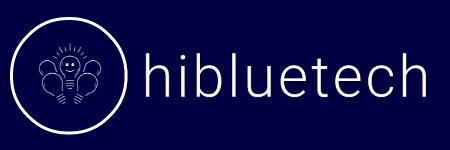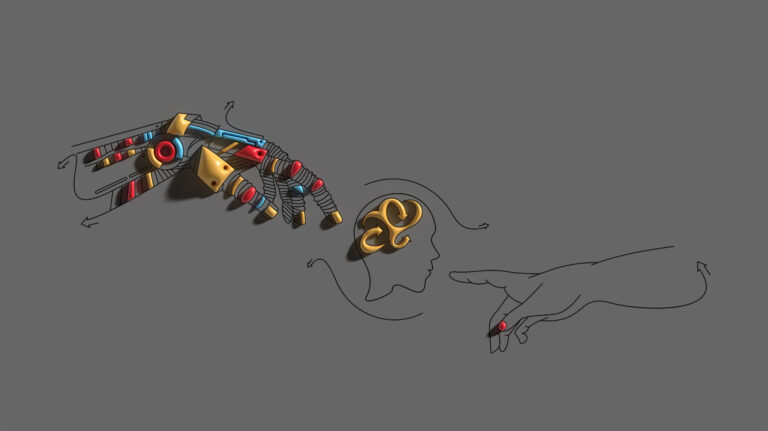You’re not weak for feeling overwhelmed or frustrated by AI tools. In fact, what you’re experiencing is so common it has a name: AI Overwhelm. I see people every day staying up late, scrolling through endless updates and new platforms they think they need to master, all because what they’re using isn’t giving them the results they want.
AI was supposed to save you time, but chances are it’s doing the opposite. I know, because I fell into the same traps. I let AI rewrite my content so many times that I lost my own voice, thinking it somehow knew what I was writing and what my goal was.
It wasn’t until clients started complaining that I pulled back and really studied these tools. That’s when it hit me: AI works a lot like our phones: input and output, but with a few surprising twists. And in this article, I’ll show you exactly what they are.
Table of Contents
The Tool Rule: Why Fewer AI Tools Eliminate Overwhelm
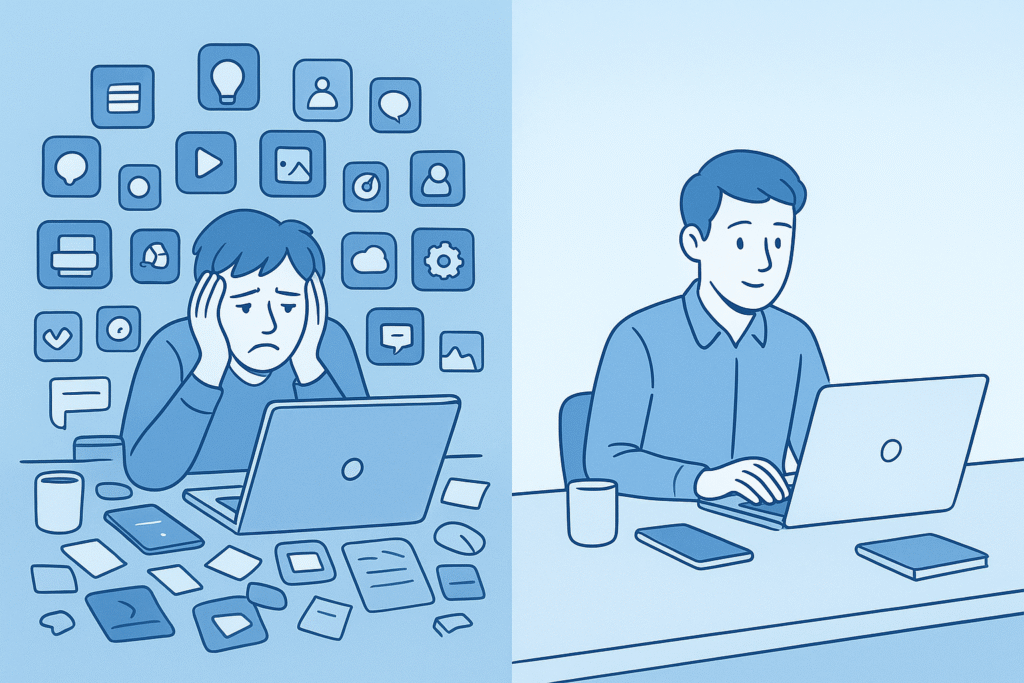
Here’s what I’ve learned from watching people succeed with AI: more tools won’t make you more productive. The smartest users I know aren’t collecting AI apps like Pokemon cards. They pick three or four tools that actually solve real problems and stick with them. Each new AI tool you add means another password to remember, another interface to learn, another thing that can break down on you.
This applies to your situation too. Skip the endless toolbox approach. Get a small set of reliable tools and really learn how they work.
The Cognitive Load Reality
Your brain can only handle so much. Every time you add another AI interface, you’re forcing yourself to memorize new buttons, shortcuts, and those weird little quirks each platform has. This mental juggling act is probably draining your energy faster than you realize. I bet you’ve experienced this: too many options create decision paralysis. Which tool should I use for this? Where did I save that prompt again?
Here’s what happens when you stick to fewer tools. Your brain stops wasting energy on the basics and starts focusing on your actual work. I’ve seen people get back 3-5 hours every week they used to lose jumping between different apps.
The 5 Hidden Traps That Fuel AI Anxiety and Overwhelm
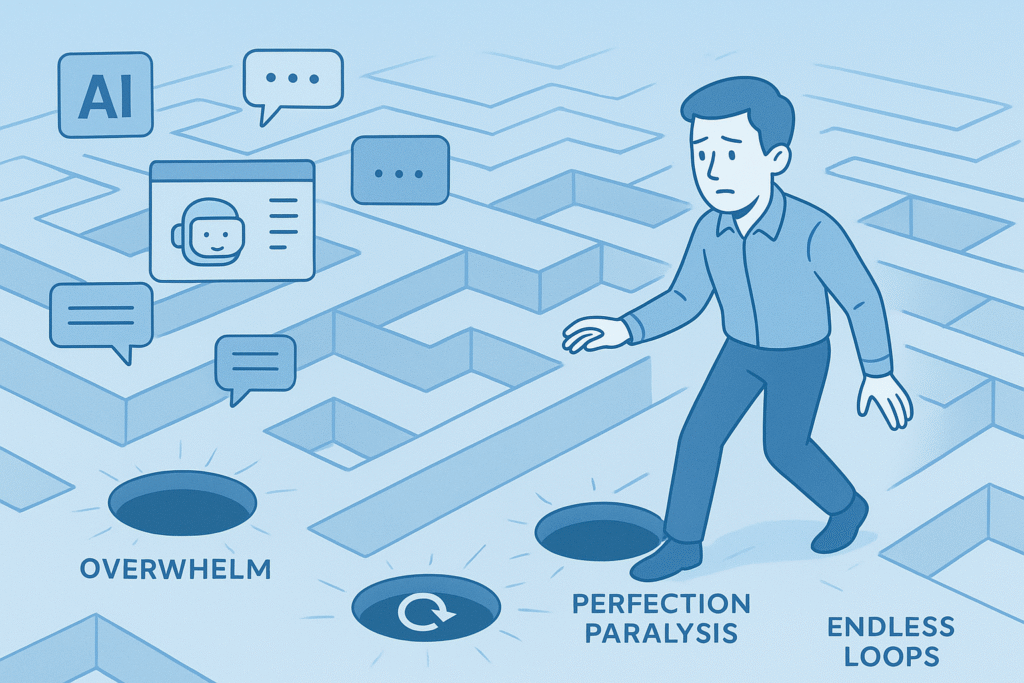
AI tools work great, but most people use them in ways that backfire. These mistakes happen constantly and probably leave you feeling worse than when you started.
Trap 1: Over-relying on AI: The Passive Consumption
The worst mistake is when you treat AI like some all-knowing oracle. You’re expecting it to read your mind instead of working with you. What happens? You get buried under generic content that sounds polished but has zero personality. I bet you’ve lost hours digging through bland drafts trying to find one that doesn’t sound robotic. Vehicle lead you questioning yourself
When you let AI do all your thinking, you lose your voice and your control. Most AI content feels hollow because you weren’t actually driving the process.
Trap 2: Perfection Paralysis
Here’s another trap: you regenerate the same output fifty times, convinced the perfect version is just one more click away. Hours pass, nothing gets published, and you’re more stressed than productive, even getting worse output.
This perfectionist mindset destroys the whole point of using AI. Instead of helping you move faster, you get stuck in loops that eat up your entire day.
Trap 3: Letting AI Make Decisions You Can’t Confidently Explain
AI suggests ideas, strategies, even project directions for you. But if you can’t explain why something makes sense, you’re in trouble. It’s like presenting homework you didn’t actually do. The moment someone asks you a follow-up question, your shallow understanding shows.
Knowing the tool isn’t enough for you. You need to understand what you’re actually building. Real confidence comes from standing behind your choices, not just copying AI suggestions.
Trap 4: Chasing the “Perfect Prompt”
Many people obsessing over finding magical words that unlock perfect results. You spend hours tweaking sentences, hunting for secret formulas, reading prompt tutorials instead of getting your work done.
Here’s the truth: there’s no perfect prompt for you to find. Clear beats clever every time. The more you fidget with prompts, the less actual progress you make on your real goals.
Trap 5: Phantom Pressure to Keep Up
Even if you’re not chasing every shiny new tool, I bet you still feel the pressure creeping in. You see those LinkedIn posts about someone “10x-ing” their workflow or your friends bragging about the latest AI hack, and suddenly you feel like you’re falling behind. That social comparison adds stress that has nothing to do with the actual tools you’re using.
Here’s my fix for you: stop measuring yourself against the hype cycle. Create your own private benchmarks for progress, like finishing one draft faster this week than you did last week. Compete with yourself, not with what you see online.
All these traps have the same problem: you’re letting the tool run the show instead of you being in control. Once you spot these patterns in your own behavior, you can flip the script and use AI the right way – as your assistant, not your replacement.
Counterintuitive Principles to End AI Tool Overwhelm
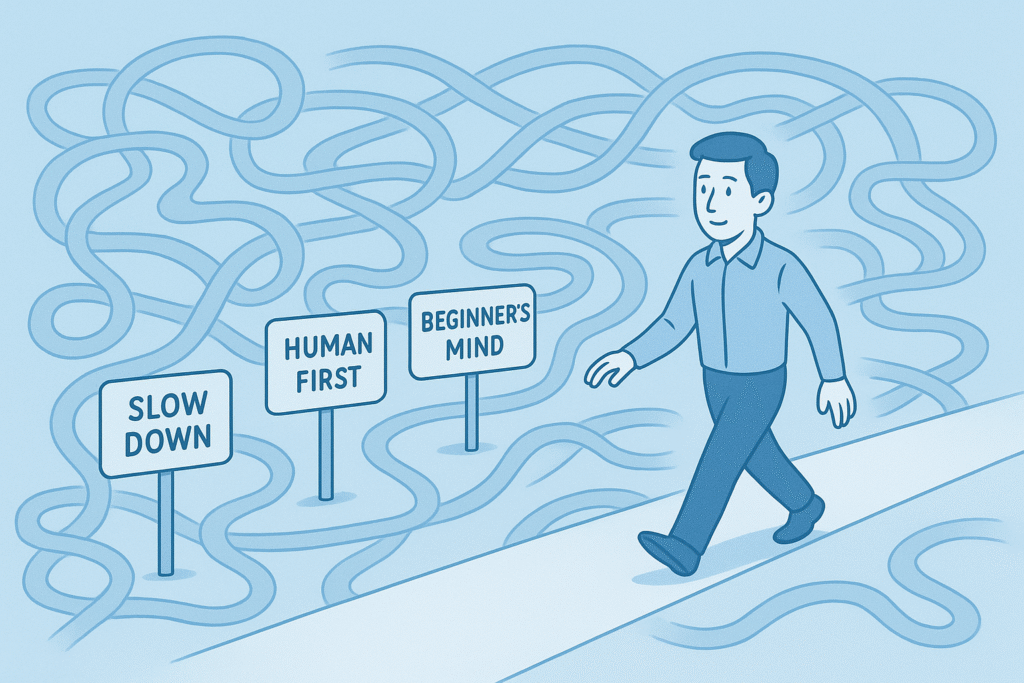
Slow Down to Speed Up
Stop hunting every shiny update that crosses your feed. Pick one trustworthy weekly newsletter about AI and focus on one thing that matters to your work. Less chatter, more actual progress for you.
Brain First, AI Second
Never start with a blank page and hope AI will save you. It won’t work the way you want. Write your rough outline or messy first thoughts first, then let AI clean it up. This way, the tool boosts your ideas instead of replacing them. Good stuff in equals good stuff out for you.
Embrace a Beginner’s Mindset
Think of AI like you’re learning Spanish or guitar. Stay curious, but ignore those “master AI in 24 hours” courses. I can tell you from experience – they’re feeding you the mindset that it’s so easy.
Reclaim Your Agency
Figure out what you want before you open any tool. Ask yourself: what am I trying to accomplish here? This is the very heart of using AI tools effectively. It flips the script from being reactive to being proactive. Then, and only then, should you use AI to help you get there. You drive, AI navigates. This is the foundation of true AI workflow optimization.
The Enterprise Focus
Choose tools that big companies actually use. They’ve got staying power and won’t vanish next month like those experimental apps everyone raves about on social media.
The 3-Layer Solution: A Real-World System to Prevent Overwhelm
The simplest way to beat AI overwhelm is thinking in three layers: one tool for thinking, one for creating, and one that connects to your daily work.
- Layer 1 – Thinking Partner: One text tool (ChatGPT or Claude) for brainstorming and rough drafts.
- Layer 2 – Specialist: One creation tool (Midjourney for images or GitHub Copilot for code).
- Layer 3 – Workflow Connector: One integration tool (Microsoft Copilot or Google Duet) that works with your existing apps.
Here’s how this actually works:
Scenario A: Writing a Blog Outline (Stay in Control)
- You do this: Write 3 rough bullet points first. Set your own direction.
- AI does this: Fill out those bullets with details while keeping your voice.
- Truth bomb: Most people use maybe 10% of any tool’s features. Master that 10% instead of chasing everything.
Here is a quick guide on how to create effective prompts for YouTube scripts
Scenario B: Editing Your Text (True Partnership)
- You do this: Write your piece, then ask AI to fix grammar or make things clearer.
- AI does this: Suggest improvements without killing your personality.
- Reality check: Like Excel, knowing half the features makes you look like an expert.
Scenario C: Deciding Whether to Use AI (Stress Test)
- You do this: Step back when AI starts making you anxious. It’s a tool, not your manager.
- Quick check: Ask yourself, “Am I using AI, or is AI using me?”
- Reset move: Break big tasks into smaller pieces so you stay in charge and avoid burnout.
Moving Forward: How to Use AI Without the Overwhelm
Here’s something that might make you feel better: 64% of marketers admit they’re drowning in AI tools right now. You’re not falling behind, you’re just being honest about how crazy this all feels. (Check out this practical AI guide for more insights.).
Yes, things are changing fast. But you don’t have to keep up with every single development. You can adapt at whatever pace works for your life and work.
The job market is shifting, but it’s not about sitting there worrying. The goal is to stop AI overwhelm from paralyzing you. Try to blend in the best way by accepting change, not complicating things for yourself.
AI can spit out a thousand ideas in seconds, but only you know which ones are worth pursuing. That human filter you have? That’s your superpower in an AI world.
So, let’s make this practical. Pick one tool from those three layers. Set one clear goal. Use it for one specific task this week. This focused action is how you shorten the AI learning curve. Skip the shiny new stuff and just get good at something useful. AI works best when it boosts your thinking, not when it replaces your brain.
The future belongs to people who stay human while using tools that aren’t. Want to dive deeper into practical AI use?
Or explore the best AI tools for human-like content writing to see which options actually feel natural.
Check out how to use DeepSeek to write a book stress-free if you’re curious about applying AI to long-form writing.
